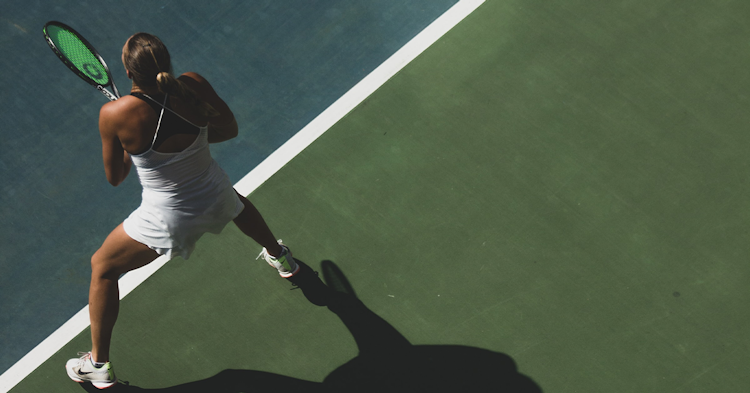At The 2021 Australian Open, Everyone Is Waiting For The Next WTA Breakout
Last updated: Feb 1, 2021, 2:58AM | Published: Feb 1, 2021, 12:36AM
It could be that at the 2021 Australian Open, we'll see a pattern we have already witnessed in recent years. It could be that hardcourt royalty will continue to amass more riches. It could be that we’re going to see an Australian Open much like the 2019 edition.
Naomi Osaka had just won the previous year’s U.S. Open, with Serena Williams making the final. Had Serena not rolled an ankle in the 2019 Australian Open quarterfinals, she probably would have beaten Karolina Pliskova and joined Osaka in the semis. As it was, Osaka beat Petra Kvitova in a world-class final and stacked together hardcourt majors at the end of 2018 and the start of 2019.
That could happen again.
Osaka is healthy and – like everyone else on tour – physically fresh due to the lack of year-end tour championships in 2020. The New York-Melbourne double is in play for Osaka, and if Naomi meets Serena or an in-form Victoria Azarenka (whom she beat in the 2020 U.S. Open final) on Saturday night in Rod Laver Arena on February 20, no one should be too surprised.
RELATED: AO 2021: 5 Unseeded Players To Watch Out For In The Women's Draw
It could be like that.
However, in this strange new world of pandemic tennis, we have seen players rise from comparative obscurity to make deep runs at majors and – in one case – win a supremely prestigious championship.
Jennifer Brady didn’t win the 2020 U.S. Open in pandemic conditions, but her run to the semifinals – where she lost to Osaka in a high-level match – marked her as a high-level WTA player. She had been building and growing and evolving for the previous year, but slowly. The 2020 U.S. Open was the scene of an acceleration in her development as a professional athlete. The time off during the first months of the pandemic was well spent. Brady trained and pushed herself and found ways to ensure that her strokes didn’t break down under pressure. A tighter, more economical, more defence-based game – with improved court coverage and better problem-solving skills – carried her past Angelique Kerber and other formidable opponents into the semis, where she gave Osaka her best match but was eclipsed by an elite opponent who rose to the challenge.
Jennifer Brady used the downtime provided by the pandemic to retool her game, and the results spoke for themselves.
Weeks later, when the focus of the tennis world shifted from New York to Paris and from hardcourts to clay, another player evolved to an even greater degree.
Iga Swiatek’s talent had been evident before the pandemic. The Pole wasn’t a surefire future major champion or a lock to become an all-time-great player (on that latter point, we still have to wait and see; one tournament does not guarantee superstardom and long-term supremacy), but she'd certainly shown enough to make herself known as a legitimate threat on tour.
In the downtime provided by the pandemic, Swiatek – like every other player – had time to think about how she wanted to play. Instead of spending late spring and early summer going through the grind of tour life, Swiatek was able to sit back and reconsider how she went about her business and what she could do to improve.
If Jennifer Brady made a big leap, Swiatek made 10 big leaps during the pandemic hiatus. She displayed a complete clay-court game and not only won Roland Garros, but destroyed the competition along the way.
Iga Swiatek hopes to win more Grand Slam titles:
— We Are Tennis (@WeAreTennis) January 27, 2021
"Roland-Garros will not be the only one. I want to prove that I can be consistent and a mature player."
(via @wta) pic.twitter.com/jWqkunEcEE
This wasn’t even close. It was a romp for two full weeks.
She played 14 sets. She didn’t lose one. She didn’t lose more than four games in any set.
Here were her scores by set in that French fortnight: 6-1, 6-2, 6-1, 6-4, 6-3, 6-2, 6-1, 6-2, 6-3, 6-1, 6-2, 6-1, 6-4, 6-1.
Some of her opponents were unheralded and unfamiliar, but most of her opponents were high-end foes. Swiatek’s first-round opponent, Marketa Vondrousova, made the final of Roland Garros the year before! Swiatek swatted her aside, no problem. Hsieh Su-Wei is a tough customer on the WTA Tour. Swiatek easily dismissed her as well. Former Wimbledon finalist Eugenie Bouchard didn’t mount much of any resistance.
And that was just the first week!
Swiatek crushed – yes, CRUSHED – Simona Halep, 1 and 2, in the round of 16, demolishing the person most tennis observers feel is the best women’s clay-courter in the world. Then, after making her way to the final, Swiatek won a close first set against reigning Australian Open champion Sofia Kenin, 6-4… and as soon as that set was one, nearly everyone watching around the world realised this 19-year-old was probably going to win her first major. Kenin is a three-set comeback artist, but she wasn’t 100-percent healthy that day, and as soon as Swiatek got a break lead in the second set, that was all she wrote.
Swiatek won 84 games and lost only 28, winning exactly 75% of all games played (meaning she won six of every eight games she played, which translates to an average set being 6-2). Let’s stop and absorb that level of dominance: Iga Swiatek played 14 sets at Roland Garros, and the average length of a set was eight games, meaning she won 14 sets by an average of a 6-2 score. That’s CRAZY!
Swiatek, on clay, might be the new queen of tennis, but on hard-courts, Osaka, Serena, Azarenka, and Kenin (as defending champion) all get first billing in Melbourne. As noted above, maybe the 2021 Australian Open will witness a reemergence of the elites, akin to the 2019 women’s tournament.
RELATED: AO 2021: Can Dominic Thiem Win The Final Battle?
Yet, if pandemic women’s tennis has surprises in store for us, we could see another WTA player emerge from the pack to create a first-time winner we didn’t anticipate.
I’m not going to spend too much time speculating on who this player might be, because the whole point of this recollection of Iga Swiatek’s Roland Garros is to illustrate how unexpected it was. I can, however, offer a brief and simple illustration of this example, just so we’re clear about the nature of this scenario if it unfolds in Melbourne.
This isn’t a scenario in which a very good and established player – who has been in the top 10 or 15 for a few years – finally gets over the hump. So, this is not Belinda Bencic or Kiki Bertens or someone in that category.
No. The kind of player I’m referring to would be someone such as Elena Rybakina. Remember her? She got on a roll just before the pandemic hit in early 2020, reaching the Dubai final before losing to Simona Halep. Rybakina has won two career titles, both at the WTA International level (so nothing at the Premier level or higher). She has four total match wins at majors in her singles career, and only one quarterfinal at any of the WTA 1000 tournaments (formerly known as Premier Mandatory or Premier 5 events). Like Swiatek before the pandemic, Rybakina has done enough to be noticed as a player who could one day be a threat, but she's not in the top tier of major championship contenders according to most (if not all) evaluations.
The 2021 Australian Open could give us Osaka or Serena or Azarenka or Kenin in the semifinals and finals… or it could give us the hardcourt equivalent of what Iga Swiatek became at Roland Garros this past October.
We’re all eager to see if the Australian Open women’s tournament will give us one pronounced path, something very different, or maybe a mixture of the two.
Did you enjoy this article? Join our free mailing list to get the best content delivered straight to your inbox, or join the conversation by leaving a comment below or on the Stats Insider Twitter or Facebook page.



